Towards the end of 1921 gold miner Fred Grisdale was dying of pulmonary tuberculosis in hospital in the mining community of Kingman in Mohave County, Arizona. He told people he was from Oregon and gave the names of some friends there and in Los Angeles, but he refused to name his parents or even mention his wife and child. What was Fred’s story?
Fred died on Christmas Eve 1921. His death certificate gives his age, 43, and his Oregon place of birth, but regarding the names of his father and mother it says that he ‘refused to tell’ and ‘information refused’. Six days later the Mohave County Miner (Kingman, Arizona) announced:
Fred Grisdale a miner aged about 43 years died at the county hospital in Kingman last Saturday after an illness covering a long period. Death was due to tuberculosis. Deceased gave the names of friends in Oregon and Los Angeles but so far nothing has been heard from them and it is probable that burial will take place here.
So Fred was buried in Section 17, Lot 2, Grave 31 of Kingman’s Mountain View Cemetery.
We know that exposure to silica dust increases the risk of pulmonary tuberculosis, particularly among gold miners who drill through hard rock. And Fred was a gold miner. Where had he come from? Who were his family? And why did he refuse to name them?
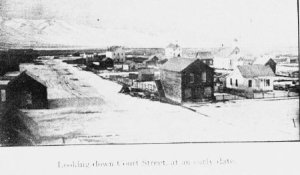
Baker City, circa 1900
Frederick Grisdale was born on 8 November 1878 in Oregon, probably in the town of Roseburg in Douglas County. He was the fifth child and second son of Thomas Grisdale and Elmira Clements. Thomas had arrived in the United States in 1850, aged 11, with his brother Joseph and parents Doctor Grisdale and Mary Greene. They came from the cotton mill town of Bolton in Lancashire, England. I wrote about the family previously; how they had first moved to the cotton mills of Pennsylvania and how, later, Thomas set off on a long journey across the breadth of the continent, via Montana, Iowa and Missouri, marrying and having children on the way. By 1873 the new family had reached Salem in Oregon and then moved to Roseburg, where Fred was probably born, and from there to their final destination in the gold-boom town of Baker City, Oregon. In 1880 Thomas was a brick layer in Baker City and the children were in the local school.
As Baker City grew in population—300 in 1870, 1,200 in 1880, 2,600 in 1890, 6,600 in 1900–all the downtown frame buildings were replaced by buildings constructed of brick and native tuff stone quarried at Pleasant Valley. The most impressive brick building still standing on Main Street is the elegant Geiser Grand Hotel, which the Warshauer brothers, Jake and Harry, constructed in 1889. It went by the name Hotel Warshauer until purchased by the Geiser family about 1900.
Thomas Grisdale probably worked helping to construct some of these buildings. One local historian writes, ‘Baker City was a bawdy place in the late 19th century. One block of Main Street boasted five saloons and several brothels, yet more refined tastes also had a place in the “Queen City of the Mines.” An opera house lent the Oregon hinterlands a little taste of Europe, and the ornate Geiser Grand Hotel was considered the finest between Salt Lake City and Seattle.’
The growth of the town was all due to the discovery of gold. ‘The area had been a mere way station for pioneers on the Oregon Trail, but the region’s fate changed in 1861, when the discovery of gold in nearby Griffin Gulch sparked decades of frenzied mining in the Blue Mountains. Towns sprang up, among them Baker City, named for Edward Dickinson Baker, the U.S. senator from Oregon who died fighting in the Civil War. By the beginning of the 20th century, Baker City was home to 6,700 people… ‘
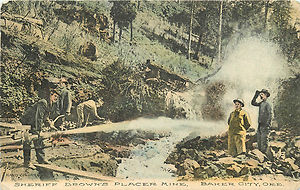
Placer Mine, Baker City, Oregon
To start with the Baker City mines were so-called ‘placer’ mines. ‘Placer mining is frequently used for precious metal deposits (particularly gold) and gemstones, both of which are often found in alluvial deposits—deposits of sand and gravel in modern or ancient stream beds, or occasionally glacial deposits. The metal or gemstones, having been moved by stream flow from an original source such as a vein, is typically only a minuscule portion of the total deposit. Since gems and heavy metals like gold are considerably more dense than sand, they tend to accumulate at the base of placer deposits.’
In Baker City, the placer operations involved running water and gravel through sluice boxes to sift out the heavy gold flakes and maybe also a few valuable nuggets. By 1900 both Fred Grisdale and his older brother Thomas Edward were working as placer miners near Baker City.
We don’t know if Fred and his brother spent any money they made in the taverns, dancing houses and brothels of Baker City, though it might be a good guess. But something must have happened to estrange Fred from his family. Whether it was his marriage in 1904 to Wisconsin-born Laura Hamblin, or something else, remains a mystery. Whatever the case, Frederick moved from Oregon sometime in the first decade of the twentieth century, either before or after his marriage. One historian of the family wrote that Fred had, ‘left home at an early age and was never heard from again’. He had simply disappeared from his family’s lives.
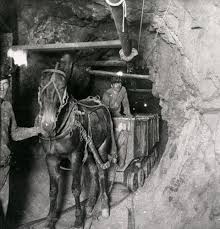
A Missoula Mine
But we can follow him. By 1910 he was living in the Montana gold-mining town of Missoula with his wife Laura and Montana-born daughter Evelyn. Here we find the first clear signs of his refusal to say anything of his parents. In the Federal census, while his wife Laura gave the places of birth of her parents (New York and Canada), Fred refused to say. The entries read, ‘unknown’. Freddy was still a miner, though by now working underground. Like Baker City, Missoula was a gold and silver boom town. The town was founded in 1860 and named Hellgate Trading Post while still part of Washington Territory. By 1866, the settlement had moved five miles upstream and renamed Missoula Mills before being shortened to Missoula. In 1910 one downtown part was still called Hellgate Township and this is where the family lived.

Tonopah Extension Mine, 1912
But being a miner was a precarious business and miners were constantly moving in search of work. Sometime over the course of the next few years the family moved again, this time to Tonopah in Nye County, Nevada. In 1918, Fred was working for the Tonopah Extension Mining Company and living in East Pine Street. A History of Nye County gives a little flavour of how miners were hired in Tonopah:
In the era when miners worked for a day’s pay, a person obtained a job by “rustling” at the collar of the shaft. That is, he put in an appearance at the shaft, making it known that he was looking for a job. The old-time mine foreman did the hiring, not the manager or superintendent, although they might recommend someone to the foreman. The person who was hiring seldom used an employment agency, preferring to look at the man he might hire. The foreman wanted to see how healthy the prospective miner looked and whether he seemed capable. If the foreman did not personally know the miner, and if the man did not come well recommended from someone whom the foreman respected, he would take the man into his office and quiz him. He might not even ask about mines, but he could tell by the way the man talked whether or not he knew anything about mining. Mines had varying hiring times, but a lot of miners rustled at noon when the foreman came out of the shaft for lunch, though some miners tried to catch the foreman as he went down into the mine in the morning. Sometimes an unemployed miner would learn about a job from relatives or perhaps a friendly person in a bar might say, “Christ, there’s a bunch of guys quit last night. You’d better get out there tomorrow morning.” One thing that would finish a miner in search of a job faster than anything was for him to follow an ambulance up to the mine. People in town knew when there was an accident; they would hear three blasts on the bell or whistle and the ambulance would head for the shaft. Though foremen were sometimes gruff, had rough exteriors, and might not be able to give a man a job, some were known to give their lunch to a hungry man.
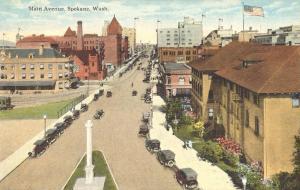
Spokane, Washington, circa 1920
Fred was drafted into the US Army on 12 September 1918 in Tonopah. He gives his occupation, employer, date of birth and his wife’s name and address, but no mention of his parents of place of birth. Whether Fred actually had to serve I don’t know. It’s possible he was sent to Los Angeles, (as his brother was to be), and there met the ‘friends’ referred to in the newspaper notice I started with. But in any case, the First World War was over and with it the demand for many of the war materials mined in Spokane was drying up. The family had to move again, this time to the mining town of Spokane in Washington State.
In the 1920 trade directory for Spokane, Fred is listed as a miner living in College Avenue and his wife is given as Laura. But this information was probably already out of date, because in the 1920 census his wife Laura and 11 year-old daughter are living without Fred in Douglas Crescent, Spokane, and Laura is said to be ‘divorced’! There is no trace of Fred anywhere. Had Fred left Laura? Had she thrown him out? Was Fred already ill? Who knows.
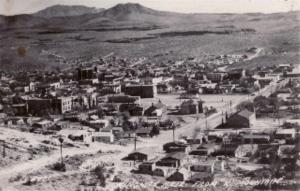
Kingman Arizona
So Fred, divorced from his wife, estranged from his family, set off one last time to seek work in the mines. This time he found himself in Kingman in Mohave County, Arizona. Kingman was founded in 1882, when Arizona was only a ‘Territory’. There were gold, turquoise and other mines. Being at an elevation of around 3,300 feet, it’s not quite as hot as one might imagine. But Fred was probably already ill and if he worked in the Kingman mines it can’t have been for long.
And here it is that I end this sad tale. Poor Fred would never mention his parents to his last breath. He didn’t even mention his former wife and his only daughter. When his ‘friends’ in Oregon and Los Angeles were contacted there was no reply. Did his daughter ever know what happened to her father? It seems his family back in Oregon did not.
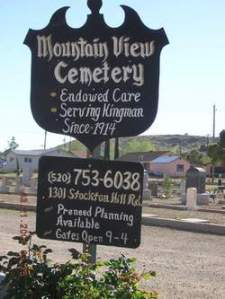
Mountain View Cemetery, Kingman, Arizona
So if you’re ever passing Kingman, Arizona, pop into the Mountain View Cemetery and think about lonely Freddy, the grandson of an enterprising Bolton cotton weaver, a descendant of the Matterdale Grisdales; a man for whom life didn’t seem to go quite right.